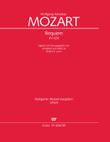Solo voices, SATB chorus, orchestra (2 Corni di bassetto, 2 Fg, 2 Tr, 3 Trb, Timp, 2 Vl, Va, Bc)
SKU: CA.5165203
Completed and edited by Howard Arman. Composed by Wolfgang Amadeus Mozart. Edited by Howard Arman. Arranged by Howard Arman. Vocal score. KV 626. Duration 50 minutes. Carus Verlag #5165203. Published by Carus Verlag (CA.5165203).
ISBN 9790007294243. Key: D minor. Latin.
The English conductor and composer Howard Arman has presented us with a completed version of Mozart’s Requiem. “Another one?” you might ask, since this publication is only the latest in a long line reaching back to the traditional Süßmayr version. Yet such is the enormous power of Mozart’s score that the challenge and appeal of completing it remain undiminished. After two decades of intensive study, Howard Arman’s additions to Mozart’s great original show the requisite care and respect while incorporating many new insights.
Arman’s approach is particularly fruitful. Always aware of the appropriate limits to such re-creative work, he orients himself towards the typical characteristics of Mozart’s brilliant composing style: The masterly compositional technique, the search for innovative solutions to every problem, and even the terse treatment of the text with extremely suggestive harmonies. All of this leads to a number of new listening experiences. In the Tuba mirum, for example, we enjoy a warm, cohesive ensemble sound, supported by the bassoons, which depart from the bass line. The Confutatis presents a quite different picture: Even the basset horns are drawn down into the infernal depths. This effect is reinforced by the independence of the trombones; rather than simply following the choral parts, the instrument’s unique sound is given an opportunity to shine. Arman’s Lacrimosa achieves a lively Mozartian feel by granting the voices considerable freedom rather than following a rigid pattern. And he concludes the movement with a fugal Amen, whereby the focus is not so much on the counterpoint itself, but rather – in the spirit of Mozart – on creating a sense of drama and illuminating the theme in all its possible facets. Mozart’s fragment ends with the Hostias, and so does Arman’s completion.
For the four following movements (Sanctus to Communio) we have nothing from Mozart, and so here, where the master is silent, Arman finally returns to Süßmayr, the man who was closest to Mozart at the time of his death and whose efforts to fill the blank manuscripts still garner our respect today.
Arman’s version has already proven its practical value. The premiere with the Bavarian Radio Choir was enthusiastically received by audiences and press alike – and celebrated as offering a scholarly, entirely fresh perspective on Mozart’s masterpiece.
- World premiere by the Bavarian Radio Choir
- Enthusiastically received by audience and press.































































